In this article, I’m going to open up the kimono and give you an inside look at a conversation I had last week with someone in one of my Mastermind groups. These conversations are typically private, but I asked Jordan if he’d be open to me sharing the discussion we had with all of you, and he said yes. Here’s the plan we put together for helping his software business find, and ultimately sell, high-value clients.
Before you hit that back button, know that this article will help you — even if you aren’t an optimization consultant who works with ecommerce companies.
My goal is to help you take many of the strategies and techniques that Jordan is using and apply them to your own business – regardless of what type it is.
Who’s Jordan Gal, and what was he struggling with?
Like many freelance consultants, Jordan has wanted to escape total dependency on client work. A little over a year ago, he set out to build his own software-as-a-service (SaaS) company, which is not an easy task — especially when you’re not technical. He ended up partnering with a developer for the development of his product, CartHook, and he’s put together a great product that helps online stores “recapture” people who add stuff to their shopping cart, but for whatever reason don’t buy.
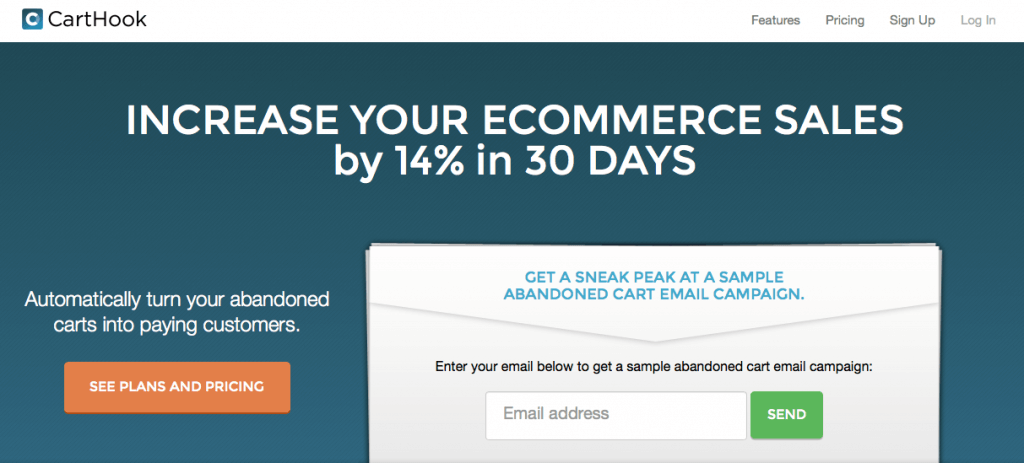
But the question Jordan’s been wrestling with is: should he continue building CartHook according to the standard SaaS game plan of getting lots of clients paying a relatively small amount of money per month, or should he do something different? When a lot of us approach building our own product — whether that be an ebook, a mobile app, or a theme — we’re easily led astray by back of the napkin calculations. “If I could just get 1000 people paying $50 a month, I’d be set!”
The challenge is that $50 a month isn’t a heck of a lot of money, especially given the amount of high-touch sales that typically accompanies an early product. Jordan, who’s a gifted salesman, has started to realize that he’s putting the same amount of time and effort into closing a $50 a month account as he’s used to putting into closing a $50,000 project! If he could do the same amount of work, but end up with an account that generates 10x the revenue, he should probably spend the majority of his time doing that.
To be honest, this is where most fledgling founders fail. I’ve talked before about how you should treat new products as a high performing portfolio asset, and not an income replacement, but a lot of people — especially burnt-out-from-client-work freelancers — switch wholesale from whatever it was they were doing to products. And when these products end up not making them the money they were expecting to make after launching, they throw in the towel. I’ve known Jordan for a while now, and I know he has no plans of doing so.
“Should I maybe change the kind of customers I’m seeking? What if I went after $5,000 a month accounts instead of $50 a month accounts?”
…Asked Jordan to the group.
The problem was immediately obvious to me. Jordan wasn’t currently going after the big brands of the world. Those companies are sold cart abandonment software by salespeople in suits. He was going after the mom and pop retailers of the Internet.
The issue is, these people typically have no freaking idea what “cart abandonment” is, and that they should even be looking for it. So here’s Jordan, with his website that’s asking small online shops to buy into his cart abandonment software, and the right people weren’t looking.
Now, don’t get me wrong. His headline is strong. “Increase your ecommerce sales by 14% in 30 days.” It doesn’t matter if you’re Sally’s Custom Fruit Baskets or Amazon, you’d love to bump up your sales by 14% in a month. But if Sally’s Custom Fruit Baskets doesn’t know they should be looking for that, how are they ever going to find CartHook?
The problem most freelancers have…
We’ve hung up our shingle, proudly advertising that we’re available to do [whatever it is you do].
But there’s usually a disconnect. We design websites, but require our clients to first figure out that they need a new website. Or we write amazing copy, yet require our clients to realize they have a messaging problem and seek someone out like us.
CartHook was betting that store owners would realize that they had a problem with people bailing before they paid, were aware of the fact that this problem can be solved (and this is a BIG assumption), and then go to Google to try to find an answer. That’s a lot to ask of Sally and her fruit baskets.
 I want to tell you about my friend Joe.
I want to tell you about my friend Joe.
Joe makes amazing, custom outdoor cushions and slings. His ex-wife, who was pretty good with Google AdWords, set him up with some campaigns that have been reliably sending him traffic and allowing him to sell hundreds of thousands of dollars of cushions and slings online.
I remember my wife and I were having dinner with Joe one night, and we were talking to him about his business. One thing he said stopped me in my tracks:
“Yeah, each winter I unfortunately need to lay everyone off. No one buys in the winter, so there’s nothing for them to do.”
This baffled me. His business has a lot of people who buy new cushions and slings every few years. Usually, they make these buying decisions in early Spring, when people are starting to hang out on their patios again. Joe knew that these people would order, and they’ve ordered from him before, but he didn’t think like I — a guy who consults on these topics — thinks about these problems.
“Couldn’t you just email past buyers with some incentive to get them to buy in December, and even out your workload?”
“Email?” he asked, “Don’t you just email people their receipt?”
Joe didn’t really know he was able to email his customers. His ecommerce software automatically sent receipts, but that was it. He’s never emailed any of his customers.
And I know for a fact he’s never heard of “cart abandonment.”
So could Jordan sell to people like Joe? And how does he find them? And what should he pitch?
Software-As-A-Service-As-A-Service (SaaSaS)
I first heard of SaaSaS from my friend Patrick McKenzie, and I think it was sometime around when we hosted our first Recurring Revenue For Consultants workshop.
The idea is that there a lot of great products out there that are missing out on customers because they’ve positioned themselves toward people who already know that services like theirs exist, and — most importantly — know how to use them.
CartHook, as I described above, is like that. Optimizely, which makes it easy to run split and multivariate tests on your website, would be incredibly helpful for a lot of highly-trafficked websites… if only the owners knew that Visitor A could be served one headline, and Visitor B another.
I ended up recommending that Jordan find the online stores of the world that are presumably losing sales due to cart abandonment, and reach out to them directly. But rather than just promoting his software, promote a turnkey solution. No software. No logins or passwords. No need to ask anyone to paste some tracking code into their ecommerce platform. Just pay Jordan, and he’ll get you more sales.
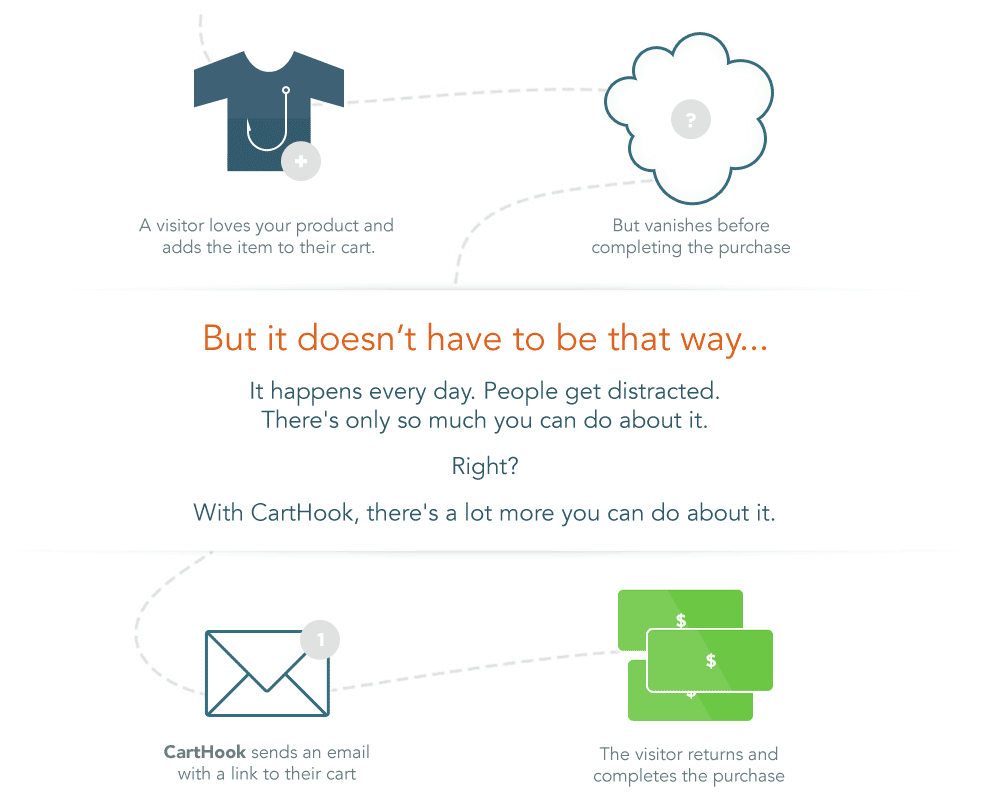
In the background, though, Jordan will be using CartHook. He’ll be dogfooding his own SaaS on behalf of his customers.
I told him to reach out to Joe, but I also explained what I would do to find these first customers.
Step 1: Come up with a short pitch
Before Jordan reaches out to store owners, he’s going to want to come up with a really strong pitch. He’s going to be cold emailing people out of the blue (for now, at least — he could set up some great content and automation to streamline the sales process, but that’s for another article), so it’s especially important to make his pitch concise, and make it actionable.
What does everyone who sells anything online want? More sales.
While CartHook.com does a good job now of highlighting that the product can help you make more sales, it’s still positioned as an app. There are screenshots with examples of email templates, dashboards, and so on. And while that appeals to a particular kind of customer (me, for example), I’m not the kind of customer Jordan’s looking for. He’s going after the Joe’s of the world: those who are reasonably successful at selling things online, but have awareness and technical knowhow barriers keeping them from being even more successful.
Hi , I was browsing through your store the other day and realized you never followed up with me after I added to my cart but didn’t buy.
I manage a few online stores, and have seen an average of around 14% in additional sales after setting up a few automated systems — e.g. bringing back people who shopped but didn’t buy, prompting a special offer when someone tries to leave the website, etc.
Would you be open to jumping on a 15 minute call this week to see if adding these systems to your store would make sense? I have Tuesday @ 10am EST and Wednesday at 2pm EST available.
Here’s my schedule – choose anytime that works for you: http://meetme.so/FooBar
Let me know. Cheers,
Brennan
At this point, I wouldn’t be going in for a sale. I first need to educate them — so my initial volley is to teach them that it’s possible to setup automated systems that bring people back to the site.
Also, I’m a big fan of a tool called ScheduleOnce (which is where that http://meetme.so/… link comes from). It ties into your calendar, and makes it super simple for people to book a time slot with you. It also makes you look a LOT more professional, and cuts back on a ton of back-and-forth.
Step 2: Find some leads
At first, I’d just start cold contacting people.
I know a lot of us can’t stand the idea of cold outreach (it’s spam!) But it can work, especially when you have a solid pitch and you aren’t going in for an immediate sale.
When many freelancers think about cold contacting, they think of saying something like:
“Hello? Hi, my name is Brennan Dunn and I’m a website designer. I was wondering if you might be interested in redesigning your website? *Click*”
There’s nothing about redesigning a website that means anything to anyone, especially an unsuspecting prospect who didn’t wake up this morning thinking about a new website. But when you shift from a sales-first to a teach-first mentality, you can then effectively leverage cold contacting techniques.
Let’s look at the pitch I outlined above, and see what it communicates:
- You’ve seen what they’re doing
- You’ve pointed out a few issues that are holding them back
- You’ve explained that they can be solved
- You’ve given a concrete example of happens when they’re solved (and asked them to mentally multiply their sales by 1.14)
See how much can fit into such a small pitch?
Now, where’s Jordan going to find people to pitch? He rightly values his time, and realizes that finding websites that do or don’t do something is the very definition of commodity work — which is a trap you should AVOID yourself. So this is a perfect job for somebody on oDesk or Elance.
1. Find researchers
I’ve used oDesk in the past to do some data collecting dirty work for me in the past. Here’s an example of a job posting from 2 years ago:
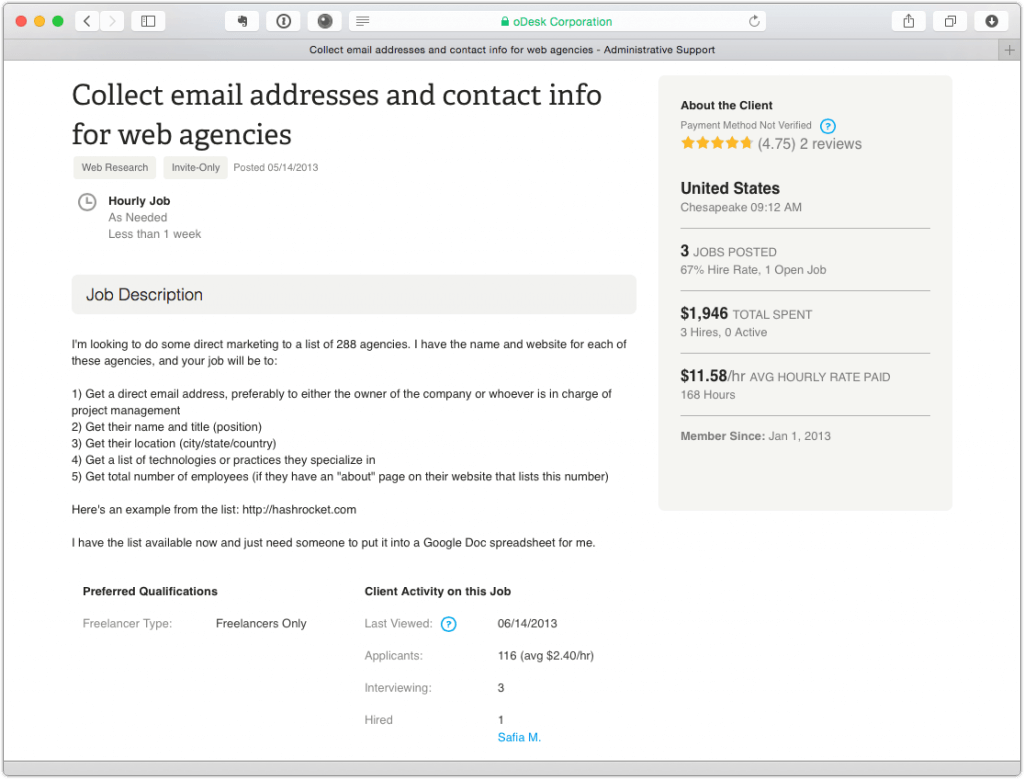
Instead of making these jobs public, I labeled them as Invite-Only and found the top rated “web researchers” on oDesk. You’ll notice that my job description is very cut and dry — I’m not looking for a consultant, instead I’m trying to find someone to do what a computer should be able to do for me but can’t yet.
Jordan’s going to want to do something similar. He wants to ultimately compile a list of a leads that he can contact with his pitch, and he needs enough information to fill out his variable placeholders (at a minimum: an item in the store’s inventory and the company name).
In the above example, I wanted to take a list of logos and URLs on Heroku’s “Partners” page, and turn it into a spreadsheet of company owners, contact emails, locations, company size, technologies, and so on. I ended up using this to cold contact a number of candidates for my SaaS, Planscope, which worked very well. I’ll be showing you how I bulk contacted these leads in a minute.
2. Create a simple screencast that shows exactly what you need done
I’d recommend that Jordan hires two or three candidates who apply to his job posting, and produce a short little screencast that demonstrates exactly what he needs done. Again, and for lack of a better way of putting it, what you’re looking for is a human machine — not a consultant.
While that’s happening, he should record a screencast that shows himself doing exactly what he wants the person he ends up using on this project to do.
In this case, it’s probably something like:
- Find a medium sized ecommerce business. Sites like NerdyData can make it easy to find sites built off some of the common ecommerce platforms.
- Go through the buying experience. Create an account (using a Gmail address shared with Jordan) and add some stuff to a new cart. Quickly look through their code to see if there’s any Optimizely or Visual Website Optimizer code. Try to move the mouse to the top of the browser window – did anything come up to try to stop them from doing that?
- Wait a few days. Did the website followup with you at all? Have you gotten any sort of email from them other than, “Your account’s been created?”
- Note the company name, a direct email address, the URL, a phone number, and the results of what we found above.
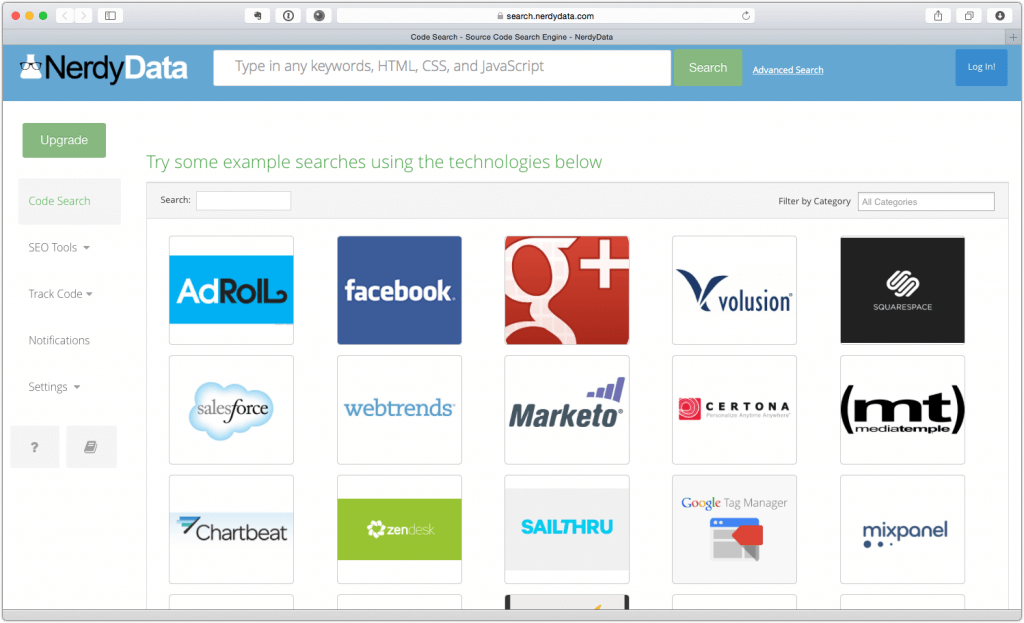
Once he’s produced this video using software like ScreenFlow (for Mac) or Camtasia, he’ll upload it to YouTube and mark it as unlisted. He’s now going to share this video with the people he’s interviewing for the position, and hire them conditionally to try this out on a handful of possible candidate companies.
3. Generate a lead list
If you end up doing something like this for yourself, you might be tempted to try to generate a massive list of leads.
I’d start small — maybe 50.
You’re going to want to use something easily shareable, like a Google Spreadsheet. This will also help you keep track of what the person (or people) you hired are working on.

You’re going to end up using this data to help you write the emails you’ll be using to cold pitch these companies.
4. Contact your leads
In the above example, I showed you a job listing I put on oDesk for generating a list of web agencies. I ended up getting about 600 companies in my spreadsheet. 40 of them responded, 20 of which became phone calls, 14 signed up for trials, and 6 converted to my $99/$199 tiers, each of which have lifetime values in the thousands of dollars.
So I ended up making $12,000+ in sales for something that cost me a few hundred dollars on oDesk and 20 phone calls. Not too shabby, especially since — at that point of my business — I was interested in learning as much as I was in selling.
For your business, your margins should be significantly higher. People like my friend Joe could conceivably pay Jordan a few thousand a month for his productized service, and quickly end up as accounts worth tens of thousands of dollars each.
You’re probably asking yourself: Did I really write 600 emails?
Nope!
I used Tout, which is a great little app that lets you pull in a spreadsheet (like the one above), stuff it into a template, and fire off emails. It’s a bit like Mailchimp or any given email marketing application — but tailored for high-touch sales.
Tout will also show you who read your emails and who responded, which is super useful for refining your templates over time (you want to end up using the pitch that gets the most responses, and ultimately, sales).
But don’t sign up for Tout just yet.
Sending 50 emails from Gmail isn’t that hard. You could, and should, be using a rough template pitch, and tailor it each time you contact a prospect company. And since at this point you’re still shooting in the dark, you’re going to want to greatly vary that template when you’re just starting out. Incremental improvements should be made much later in the game.
Step 3: Go in for the sale
Now, what should Jordan do when somebody responds?
He’s going to want to try to figure out as much as he can about the health of the ecommerce website, what sort of daily sales they net, how much they’re currently spending to get eyeballs on the page, and more. There needs to be a graceful transition from “I’m teaching you WHY you should care about this” to “I’m telling you HOW to solve this, and I’m best for the job.”
Jordan’s going to want to briefly explain the benefits of a few tactics that he’s seen work for him and his clients:
- Retargeting
- Email marketing (like, email Joe’s customers in December with a special offer)
- Cart abandonment
- Exit modals
- Analysis and A/B testing
All of these features mean nothing in isolation. But when you contextualize it around the payoff — that 14% lift in online sales — they become irresistible. A store owner who doesn’t do these things would need to be stupid to pass up on doing this.
But there’s still a lot of internal friction happening in the mind of the buyer, especially a non-technical manager of an online store.
“This all sounds great. But it sounds like a lot of work… (for me).”
And this is one problem with putting a SaaS or even a technical service in front of someone.
In their mind you’re saying, “Here’s the shovel. Go dig your relaxing swimming pool.” Where Jordan can succeed is to now try to quantify how well their store is doing, apply his 14% metric to their stats, and use that projected future revenue to sell them today. He’ll use the exact process I outline in DYFR to make it obvious why paying the fees he’s asking is no brainer.
Step 4: Sell it like his SaaS
When it comes to selling a service like this, Jordan’s going to price it just like he would CartHook, but at a significant premium.
Here’s what he’s currently charging people:
 With his consulting layer on top of his software, he’ll be able to charge a lot more because he’s allowing people to get customers a lot closer to the results they’re aiming for.
With his consulting layer on top of his software, he’ll be able to charge a lot more because he’s allowing people to get customers a lot closer to the results they’re aiming for.
Think of it this way:
A software product, like CartHook-sans-Jordan, is like a gold mining kit. You get the pick, the shovel, the sifter, and the other tools you need to successfully mine gold.
But the human element (Jordan and his team) is like getting that kit along with an experienced guide. They’ve been down this trail before, and can make sure you get to the gold as effortlessly as possible.
Checkout this pricing grid from PodcastMotor, a service that makes producing high-quality podcasts turnkey:
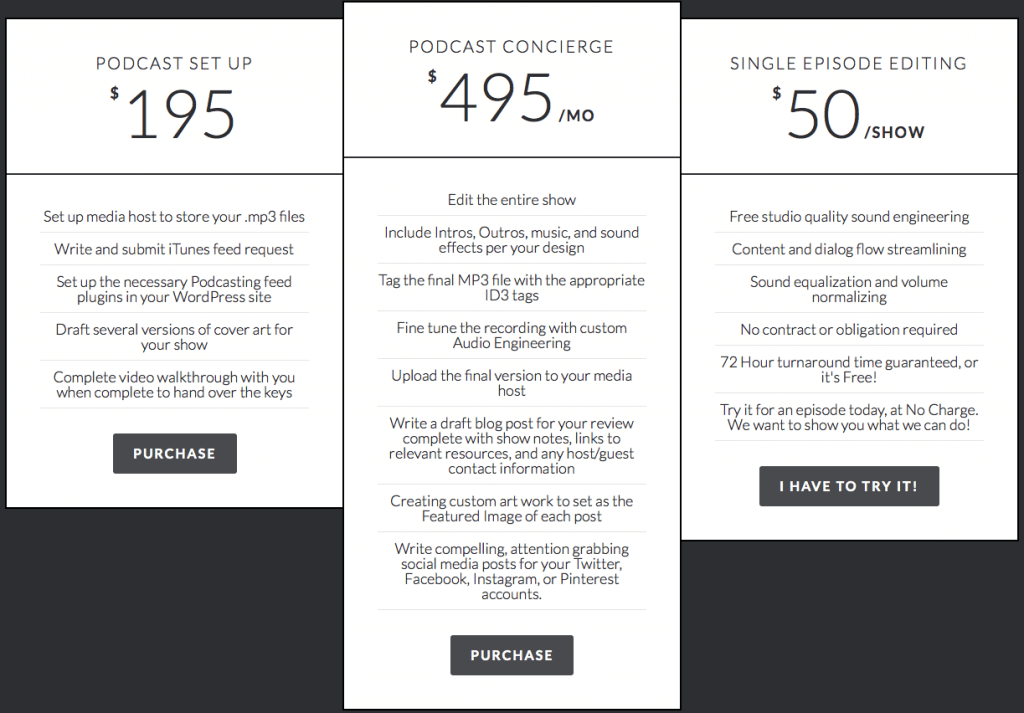
Similar to CartHook, or just about any other subscription software service right?
But behind the scenes, they couldn’t be more different. CartHook-sans-Jordan is a SaaS; PodcastMotor is a podcast consultant. One is a computer, the other is human.
To the end customer, there’s no difference. They just want their cart abandonment or podcast problems fixed.
So when Jordan goes to ultimately sell leads on his productized service (CartHook + him), he’s going to want to price himself based on how awesome the results he delivers are.
Let’s look at an example of this in practice. Here’s a screenshot from a service my friend Damian Thompson used to offer:

Damian tiers his services based on the results he’s delivering his clients, and not his time. On the low end, you’ll get basic marketing automation setup, but for 4x the price and, you’ll dominate your market.
In Jordan’s case, he’s going to want to segment his tiers around how many possible sales he can recover (or create from scratch). I’d probably spike pricing like:
- $500/month — Starter: Stay on top of rescuing more sales — we’ll make sure people who come to your site and are in the process of buying end up actually buying. If you’re making more than $5,000 a month now from your store, this pays for itself.
- $1500/month — Business: We’ll not only help you rescue more sales, but we’ll also help you make more sales by continuously refining your website. We’ll tailor your headlines, navigation flows, and more monthly to maximize sales. This is best for companies that make over $10,000 a month through their website and are looking to increase that by 30%.
- $4000/month — Total: This is our complete package. Not only will we bring more people back to your site to buy and get more people who are already on your site to buy, but we’ll also introduce an advanced email marketing strategy to bring past customers back for more. This is for companies that make over $20,000 a month through their website and want to double their sales.
I’d start with something like this. Because the cost, benefits, and results are tightly coupled, you’re allowing prospects to self-segment into a package that works best for them and their business. And Jordan can always tweak this over time.
Should Jordan offer a money-back guarantee?
It’s no secret that making a purchase risk-free is one of the single best way to overcome a sales objection.
The trouble with a service like the one I discussed with Jordan compared to CartHook is that it requires somebody’s time, and not just computer computation cycles. Time is a non-renewable resource. So if Jordan offers a money-back guarantee, he risks someone attempting to cash in on that and allowing the time it took to fulfill the service to go to waste.
For normal freelance consulting, I usually recommend against money-back guarantees. They’re too risky.
But a great productized service, like the one described above, should net you a very, very healthy effective hourly rate. Think of the $4k a month option — Jordan will hook the client up with his cart abandonment and exit modal code, and then he’ll run a few A/B tests each month and maybe send a newsletter or two for the client. This should only take a handful of hours, which means his effective hourly rate is in the high hundreds. Not too shabby.
If the risk is sufficiently small that the payoff ($4k/mo for N number of months) is worth the possibility that you’ll lose a few hours of time, do it.
It should be noted that you should set your money-back guarantees up to only guarantee the last month of work. Meaning, a client can’t decide willy nilly to ask for the last year of invoices to be refunded.
How can you apply this to your business?
So you might not be a conversion expert or serve the ecommerce space. That’s OK.
My hope is that the above example broke down how I think about:
- Putting together a service that looks like a product (in this example, a SaaS)
- Pricing a productized service
- Finding leads by cold contacting them (and without losing your soul in the process)
Don’t get caught up in the technicals of what I wrote. Instead, look at the process. Imagine you and I were chatting over a beer, and we had a similar discussion. But instead of increasing conversions for online stores, we were talking about the kind of work you do for your clients. What would I say? How could you translate what I wrote above into something that works for you and your business?
Was this helpful? This is really the first article I’ve written of this sort, most of my advice is intentionally general on purpose. And would you like me to research and create a guide along the lines of what YOU do for your clients? Let me know in the comments below what you’re looking for.
My goal in 2015 is to produce better tactical content and advice for you. More podcast episodes. More in-depth articles. More knock-your-socks-off, tried-and-true business strategy for freelancers and agencies like you 🙂